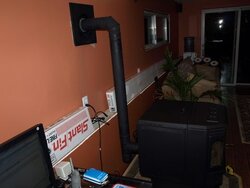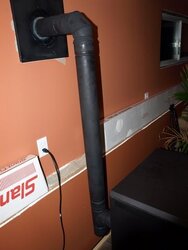Ok, totally frustrated now. Still getting smoke leak at more than one connection of pipes. Last winter spoke with Simpson tech who told me to put a bead of silicone on the inside edge of the pipe that goes into the double wall of the next pipe. I have taken apart all the pipes and resealed and I still see smoke whisping from the connections. It even looks like it is coming out of the angles of the 90° elbow. I can't run the stove more than a couple of hours before the odor of smoke gets to be too much. Is there a different way to seal the pipes????
How do I properly seal Simpson DuraVent Pellet pipe?
- Thread starter eschills
- Start date
-
Active since 1995, Hearth.com is THE place on the internet for free information and advice about wood stoves, pellet stoves and other energy saving equipment.
We strive to provide opinions, articles, discussions and history related to Hearth Products and in a more general sense, energy issues.
We promote the EFFICIENT, RESPONSIBLE, CLEAN and SAFE use of all fuels, whether renewable or fossil.
You are using an out of date browser. It may not display this or other websites correctly.
You should upgrade or use an alternative browser.
You should upgrade or use an alternative browser.
- Status
- Not open for further replies.
Swaybar
Member
If the 90's are adjustable swivel angles they may need to be sealed.
I used red high temperature permatex gasket coumpound and spray painted them with a high temp black to seal my 90's. I have not had a problem with the connecting joints. but I did pull out the rope gasket inside the joint a little to make sure it was touching the other piece.
I used red high temperature permatex gasket coumpound and spray painted them with a high temp black to seal my 90's. I have not had a problem with the connecting joints. but I did pull out the rope gasket inside the joint a little to make sure it was touching the other piece.
HEMI
Feeling the Heat
I to had the same problem....sealed all joints on pipe and elbow, and where the pipe goes through thimble (inside and outside). still had a leak.....then i kept looking and discovered it was leaking from the bottom of the T cap.....foil taped it twice, and no more leak.
jtakeman
Minister of Fire
Same here, Sealed all joints(inside while assembling and externaly including 90 seams) and tape on the tee cap. I still check them on startup, Just in case!
I
imacman
Guest
From my experience, it seems that the cleanout T is the biggest culprit in these installs (too many pieces joined together in one spot). That's the only place I had to add aluminum tape to seal a small leak. All the others seem to be OK just with the factory sealant & twist lock.
HEMI said:I to had the same problem....sealed all joints on pipe and elbow, and where the pipe goes through thimble (inside and outside). still had a leak.....then i kept looking and discovered it was leaking from the bottom of the T cap.....foil taped it twice, and no more leak.
Hemi, you say at the bottom of the T cap. Do you mean the joint, or under it where the vent holes are? I believe the smoke is getting between the walls and leaking at all the connections and the very bottom of the T cap. How much silicone do I need to put in the pipes, and am I putting it in the correct spot?
krooser
Minister of Fire
My vent transistions from a 4" (stove) to a 3"vent pipe. I ran a generous bead of red RTV silicone INSIDE and OUTSIDE the vent pipe where the two join together per the instructions that came with my vent kit. My service guy sez he sees most leaks at that point...
The rest of my pipe has gaskets and twist locks and I didn't have any leakage issues... I use a Selkirk system.
The rest of my pipe has gaskets and twist locks and I didn't have any leakage issues... I use a Selkirk system.
I
imacman
Guest
eschills said:Hemi, you say at the bottom of the T cap. Do you mean the joint, or under it where the vent holes are? I believe the smoke is getting between the walls and leaking at all the connections and the very bottom of the T cap. How much silicone do I need to put in the pipes, and am I putting it in the correct spot?
I think Hemi is talking about the removable clean-out cap at the end of the T. As for the use of silicone, I wouldn't silicone the clean-out cap.....just foil tape around it. It will be MUCH easier to remove than trying to cut all the silicone when you want to clean-out the pipes.
HEMI
Feeling the Heat
i taped the seam of the cap and the bottom....i only siliconed a small bead and spread it with fingereschills said:HEMI said:I to had the same problem....sealed all joints on pipe and elbow, and where the pipe goes through thimble (inside and outside). still had a leak.....then i kept looking and discovered it was leaking from the bottom of the T cap.....foil taped it twice, and no more leak.
Hemi, you say at the bottom of the T cap. Do you mean the joint, or under it where the vent holes are? I believe the smoke is getting between the walls and leaking at all the connections and the very bottom of the T cap. How much silicone do I need to put in the pipes, and am I putting it in the correct spot?
HEMI
Feeling the Heat
I even sealed the T cap with silicone. I used to tape it with foil tape but I wanted to make sure that wasn't leak. I have to call Simpson tomorrow.The responded to an e-mail with a contact #
I
imacman
Guest
eschills said:I even sealed the T cap with silicone. I used to tape it with foil tape but I wanted to make sure that wasn't leak.......
If you sealed it w/ foil tape, there should be no reason to use silicone.....must be other "issues" in your pipe setup.
Alan
Member
Spoke with Simpson rep. He states smoke must be getting between the walls. I told him where I was putting the silicone and he stated it should be 3/4" down the inside of the pipe that goes into the double wall of the connecting pipe. I was only about 1/4" and there is a step right below where I put it. I am taking it all apart again and resealing with Rutland Seal It Right. Supposed to be easy toe get apart so I will even do the T cap. I will let you know how it works.
krooser
Minister of Fire
nosaudioil
Member
I have a NPS40 and use Simpson Duravent and I had persistant smoke odor. My set up is in a corner with a Simpson adapter onto the NPS40, a 45, then 24" straight (including through the wall) to a exterior clean-out T, then verticle aproximately 6' with a cap. Interior, I've sealed all the joints with Rutland "Seal It Right" a DV appliance sealant. I continued to have a smoke smell. Took off the left sheet metal panel and discovered that where the Simpson adapter slid onto the NPS40 flue exit, a rivet in the construction of the Simpson adapter was allowing a leak. With the panel off I was able to seal this small area properly. This action cured the problem.
I would say that Simpson Duravent is a poorly designed product if such steps have to be taken even after the pipe is properly installed.
I'd like to use a foil tape on all the joints as well. Is this something that can be purchased at HD or other BB store? What operating temps should the tape have?
I would say that Simpson Duravent is a poorly designed product if such steps have to be taken even after the pipe is properly installed.
I'd like to use a foil tape on all the joints as well. Is this something that can be purchased at HD or other BB store? What operating temps should the tape have?
Alan
Member
nosaudioil said:I'd like to use a foil tape on all the joints as well. Is this something that can be purchased at HD or other BB store? What operating temps should the tape have?
3M 2113NA High Temperature Flue Tape, 15-Foot Roll...it' is rated at 600 degrees F.
http://www.amazon.com/3M-2113NA-Hig...ref=sr_1_2?ie=UTF8&s=hi&qid=1257645560&sr=8-2
I bought mine at a local Ace Hardware.
krooser said:I used Selkirk pipe and got a zero reading for carbon monoxide when tested... good stuff.
Great to hear that, since that's what I'm using. And even though they said you don't need to seal it with anything, I am.

Firenutz
New Member
Did you mention that you have a connection inside the thimble? I don't think that's recommended and could spread smoke smell throughout the walls if it was leaking. I've used the duravent for 2 years now with no problems. I used High temp RTV on the outside of all the joints. I even turned a 90 degree elbow to be a 45 and it doesn't leak. My only leak was where the pipe meets the stove and I found that one by checking the joints with a flashlight in the pitch black during startup.
Well I tried talking all the pipes apart and can't even get them apart. I definitely sealed them well. I have had enough. Ordering new Selkirk pipe setup.
krooser said:I used Selkirk pipe and got a zero reading for carbon monoxide when tested... good stuff.
krooser do you need to silicone seal Selkirk pipes?
krooser
Minister of Fire
eschills said:krooser said:I used Selkirk pipe and got a zero reading for carbon monoxide when tested... good stuff.
krooser do you need to silicone seal Selkirk pipes?
Nope... I only used silicone at the adaptor... the rest uses a factory seal... my inspector got a zero carbon monoxide reading so it must work pretty well.
I have the system with the interal OAK set-up that draws outside air from around the vent pipe.
- Status
- Not open for further replies.
Similar threads
- Replies
- 25
- Views
- 3K
- Replies
- 12
- Views
- 2K
- Replies
- 22
- Views
- 3K
- Replies
- 10
- Views
- 2K



